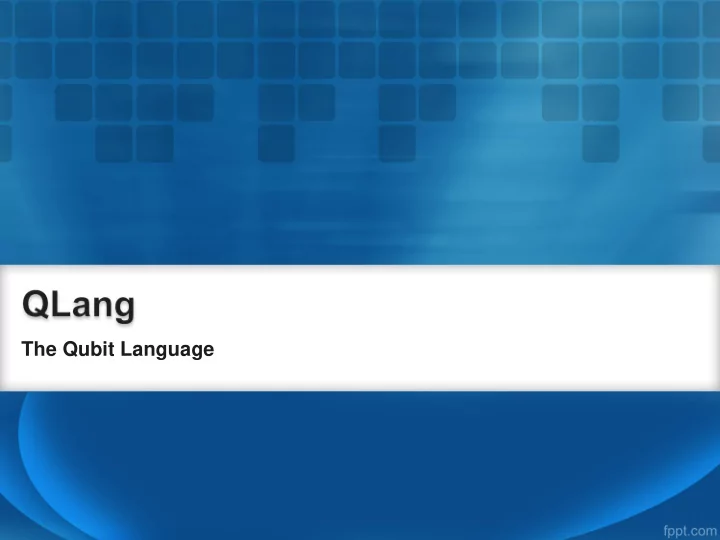

The Qubit Language
Christopher Campbell (System Architect) Sankalpa Khadka (Language Guru) Winnie Narang (Verification and Validation) Jonathan Wong (Manager) Clément Canonne (LaTex)
Quantum Computing - Computing using principle of Quantum Mechanics. - Simple analogies with Classical Computing. - Bits – 101 -> Qubits (vectors) - |101> - Gates – AND, OR, etc. -> Unitary Matrices – H , X, Y, Z
Design language to perform quantum computation and simulate quantum algorithm through • Simple and intuitive syntax • Leverage well-known and elegant Dirac notation for qubit representation. <01101| (bra) or |1010> (ket) • Significantly reduces the complexity of dealing with matrices and their associated operation such as tensor product. |0> @ |1> • Provide comprehensive set of operators for quantum computation.
def apply(mat x) : mat result { mat y; y = |0>; result = y*x; } def compute() : mat final_result{ mat x; x = [(1,1)(1,-1)]; final_result = apply(x); }
Types int (integers): 17, 0, -3489 • float (floating point): 24.2, -3., 17.006 • comp (complex): C(7.4 + 8.1I) • mat (matrix): [(1,2,3)(4,5,6)] (gates) , |1101> (qubits) • Operators (All arithmetic operations + Matrix Operations) multiplication , H * X, H * |001>, <010|*|010> • Tensor Product, H @ X, |001> @ |10> • norm, norm(|010>) • transpose, trans(H) • • adjoint, adj(Z) • conjugate, conj(C(4.+5.7I))
Control-Flow/Loops • If-else if (norm(A) eq 1){ output = 5; } While loop • while (i < 5){ print(i); i= i+1;} • For Loop for (i from 0 to 10 by 2){ print(i); }
Built-In Variables and Functions Variables H – Hadamard gate • X – Pauli X • Y – Pauli Y • IDT – Identity Matrix (2x2) • e, pi – the numbers e and pi • Functions • print(val) – prints val (takes any type) • printq(qubit) – prints a matrix in Dirac notation if possible • rows(matrix) – returns number of rows in a matrix • cols(matrix) – returns number of columns in a matrix • elem(matrix, row, col) – returns the element given by [row,col]
Return type Function name parameter Return variable def apply(mat x) : mat result { mat y; Function name y = |0>; result = y*x; } Output variable which prints Main Execution function def compute() : mat final_result{ mat x; x = [(1,1)(1,-1)]; final_result = apply(x); }
Design program scanner (symbol stream) token stream parser AST qlang lib Eigen lib analyzer libc++ SAST c++ src executable g++ generator
Structure Environment functions program fdecl fdecl fdecl scope name builtin return name params return type locals body
Structure scope params/locals vdecl vdecl name type builtin
Structure scope body statement statement expr. expr. expr.
#include <iostream> #include <complex> #include <cmath> #include <Eigen/Dense> #include <qlang> Details using namespace Eigen; using namespace std; formal function return return params name type name MatrixXcf test_add (MatrixXcf x ) { MatrixXcf y; def x2(int a) : comp result { MatrixXcf result; result = a * 2; } y = genQubit("01",1); automatically result = x + y; returned return result; } def compute() : comp final_result { int a; automatically int main () a = 3; printed { MatrixXcf x; final_result = x2(a); MatrixXcf final_result; } x = genQubit("10",1); final_result = test_add(x); std::cout << final_result << endl; return 0; }
Analyzer Exceptions
• Semantic testing – Check for incorrect syntax or logical errors. • Code generation testing – For syntactically correct code, generate equivalent C++ code. • Test phases – Unit testing – Integration testing – System testing
Test Suites • SemanticSuccess • SemanticFailures Automation • One universal script to do it all Test suite Operation runTests.sh Output
Workflow a s g c e Code Code AST SAST Execution generation compiled Exec_output
Deutsh Algorithm
Recommend
More recommend